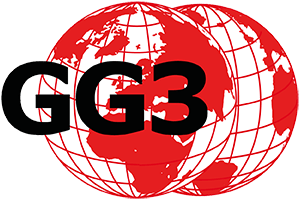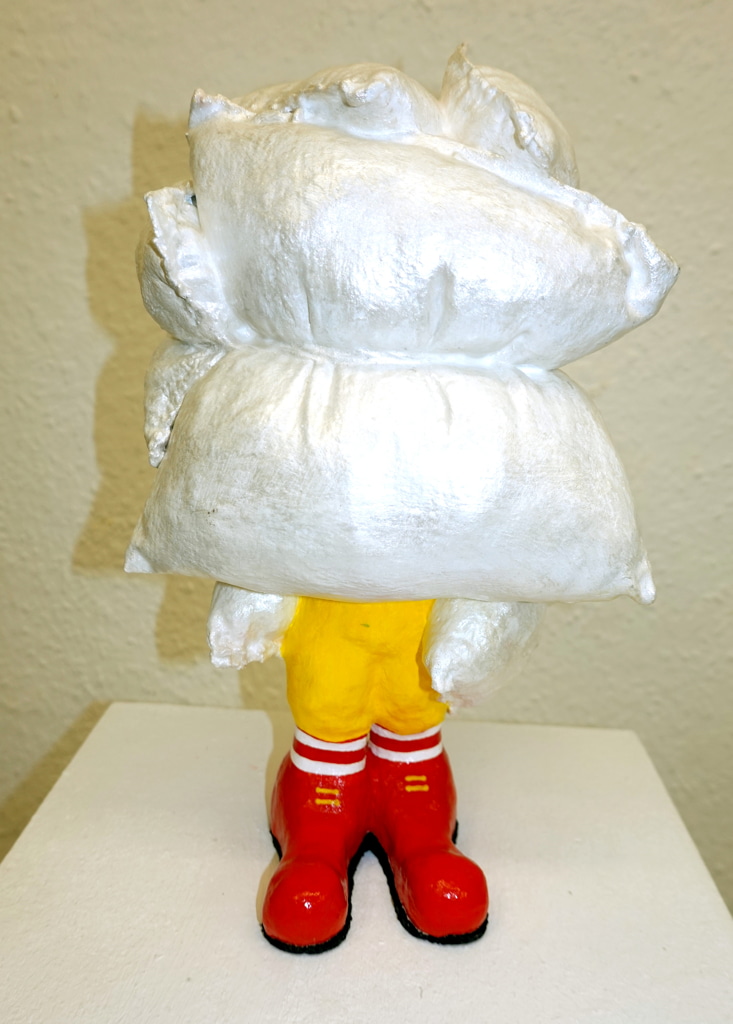In “Cat washing. Climate protection with displacement” search 2
2
artists
with 24 works
answers, reconciling climate protection with personal and social behavior. With object work, installation, video, photography, painting and performance, the show addresses our contradictory social behavior with regard to climate protection. Because conscious, responsible action towards this planet can become a challenge in a world full of consumption and luxury. It requires consistency to rebel against established social patterns and leave them behind.
Ines Hock speaks in her large-scale urban intervention
Be(e) here
in the nearby Engelbecken park, the dramatic consequences of the encroachment on nature. A flower meadow made up of 250 small plates with botanical plant names written on them moves with the breeze. However, the flowers listed are on the Red List and are therefore threatened with extinction. Hock’s work demonstrates the extent to which our ecosystem, and therefore our living environments, hang on thin threads.
LOCATION EQUAL by Stephan Groß contains both a question and a statement and was presented at the University of Bremen in 2006. In capital letters as a palindrome, the installation interweaves a personal point of view with that of our society. But are we really so indifferent to the situation? How do we deal with our individual fates? Me and the climate by Tom Albrecht playfully addresses the ambivalent relationship with our planet through interaction with the visitors. Thomas Behling picks up on the ambivalent mood towards climate protection. “It’s the environmentalists’ own fault that we are destroying the planet!” is blared at us in what appears to be an old font. The pigment print on paper from 2023 is to be understood with a wink and serves to “edify the soul tormented by moralizing environmentalists.” And Tom Albrecht’s Malle is critical and humorous at the same time. A sponge, framed in an open box, with the sentence “I always take my eco-sponge with me to Malle!” underneath. The companion made of cellulose and coconut fibers, which can avoid the need to buy new sponges, offsets the CO2 emissions of the flight of his personal wanderlust. With the Flight shame measuring device John Maibohm deals ironically with our own needs that stand in the way of climate protection. The fictitious technical device determines the individual flight shame. It is based on the St. Florian principle. This refers to behavior that does not solve potential threats or dangerous situations, but shifts them to others. The loop video WYSIWYG by Benna Gaean Maris picks up on the criticism of frequent flying. The artist directs our gaze towards the sky, awakening thoughts of longing for distance and vastness. But Maris shows: The horizon is no longer just a symbol of peace and freedom. Instead, the aerosols of the airplanes occupy the sky. In the painting European Sleeper by Daniel Theiler, from 2023, the plane remains on the ground. We are silent spectators of a moment from 2019. The figure shown, James Brown, Extinction Rebellion climate activist, glued himself to a British Airways plane that year to demonstrate against the environmental impact of flying.
Ship journeys are also major environmental impacts, which Alexander Rommel depicts in his digital painting
Ghost Ship
from 2016 was addressed. Above a recessed form of a ship’s bow on the open sea, with no ship in sight, a menacing black cloud colors the journey. Staged as a child’s play, the painting is in the basin by Joanna Lucas. A nod to marine pollution, such as spilled oil tanks: a bright blue toy boat and a bug-eyed red goldfish splashing around in a sterile white tub. But a black substance is spreading under the boat, which has already taken over the upper half of the tub and pushed the fish into the lower corner. Despite the precarious situation of the environment, we feel little immediate sense of guilt as actors. The installation
Memory from last vacation
by Anna Orlikowska uses photography, fragile ceramics and a video played on a smartphone to capture the reckless exploration of the Zugspitze in the Alps as the glacier recedes drastically.
Instead of preserving, we prefer to replace, to escape into virtual realities. Swipe The Pain Away is an interactive installation by Jens Isensee and Tobias Bilgeri . It runs synchronously on five smartphones. Almost macabre, AI-generated worlds, pretty and healthy, are suddenly shaken by catastrophe scenarios without any problems and the people watching them hold the fate of these small worlds in their hands. What should we have done? by Anja Witt describes sitting out as displacement: stereotypical miniature figures on a Styrofoam rice floe swim in the blue void. Sometimes they look up at the sky, sometimes to the side. They don’t communicate with each other, rather they seem to be waiting for the great unknown. Witt is a former oceanographer who deals with the melting of ice and rising sea levels in her art. And despite the knowledge of climate change, action remains inadequate.
“
Every detail, reflects the irony of our concern for sustainability as we continue to exploit the earth’s resources and dispose of radioactive waste underground,” says artist Danny Hermann about his oil on canvas work
Radiant Nature
from 2017. Hermann visualizes the topic of waste separation as a leching, monster-like creature. Recycling and separating waste makes us feel good and at the same time soothes our relationship with consumption. Pillow Man by Lita Poliakova was specially designed for “cat washing” and stands for the symbolic blinkers of our personal comfort. Large, red clown shoes with striped socks and yellow pants peek out from a corpus wrapped in cushions. Whether it’s fast food, which evokes associations with McDonald’s mascot Ronald McDonald thanks to the flashing outfit, fast fashion or disposable packaging. It is consumed. Maria Korporal also takes up the idea of consumption in relation to sustainability. Your video work I only drink organic fresh willow milk from 2024 shows a kitten happily drinking organic milk as a digital animation. The artist thematizes greenwashing in the packaging industry, whereby the promise of a seal of approval and the manufacturing process do not match. The artist Froso Papadimitrious questions the image of Western society; not only green alternatives are needed, but also radical changes in our thinking about the current consumer economy. In her installation
quicksand
of 2023, she works metaphorically in that the climate crisis is a quicksand pit in which we are stuck up to our upper bodies and can no longer pull ourselves out on our own.
Annegret Müller shows that pollution is global and omnipresent.
“… and then I…”
– four words that flow out of the old enamel sink of the installation and now lie there. The object of 2024 is a reservoir for all our pollution, leftovers and toxins, which are collected, mixed and passed on. Susanna Giese Installation Bonding offers a solution. Her oversized figures are made of wood, iron bars, linen, wire – and waste. They watch over the exhibition like silent observers. With their garments, made from bottle caps among other things, they show the ambivalence between the desire for change and clinging to familiar lifestyles. The artist Rosa Schmidt presents her performance WRINGEN/FURwith scenic images that make reference to planetary overuse and material waste and bring a new approach and harmony with nature. And Mari’s second work
Paperphone
offers a fresh approach, is in direct correspondence with
Swipe The Pain Away
The dependence on mobile devices has increased significantly in recent decades and we are withdrawing into them. As an immaterial, participatory work, Paperphone offers visitors the opportunity to assemble their own cell phone out of paper – without any technology.
Alla Zhyvotova‘s video work is utopian, bizarre and at the same time frighteningly close to reality.
On Sunday evening
of 2021, the Ryba family is concerned about climate change and plans to change their genes to give their children a better chance of survival. She prepares herself for a life in the water with special training and organizes workshops to promote her idea. And Susa Ramsthaler’s performance Great climate from 2017 calls for the body’s own energy storage. Since 2009, Ramsthaler has been using movement, text and voice to address climate change and how to deal with it.
“Wash my fur, but don’t make me wet. Climate Protection with Displacement” shakes and tugs at our comfortable comfort zones, holds up a mirror to us and provides impetus for a responsible approach to our world.
Text by Katja Hock

